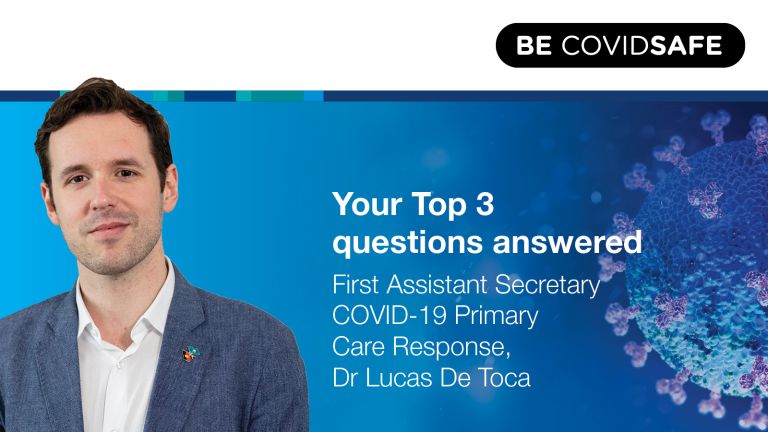
Hello, I'm Dr Lucas de Toca. And I lead the rollout of the vaccine through GPs, pharmacies and Aboriginal health services for the Australian Government.
Welcome to Top 3. Today, we're meeting on Ngunnawal Country, and we will be answering the top questions that you've been asking on our social media channels. We're going to talk about "Why do we have to do a rapid antigen tests before we brush our teeth or before we eat?" We're going to talk about screening and surveillance with rapid antigen tests in schools and why we're doing it, and we're also going to talk about whether new variants of the virus might escape tests that we have to assess it.
So, going straight into the first question. We do get asked 'why?', why is the recommendation for children that are getting tested before going to school or for people who are doing RATs or rapid antigen tests, especially the saliva ones, to do it before you brush your teeth or before you are eating? So the rapid antigen tests, which are very accurate but not as accurate as the PCR tests that we use in clinic-based testing, often come in two types. They might do swabs, nasal swabs or throat swabs or they might also do saliva swabs. The tests that rely on saliva need to be able to detect the presence of the virus in the sample of saliva. This test, the so-called lateral flow devices, and you will have seen because pretty much everyone in Australia now has done at least one RAT. You put the sample in one side of an absorbent pad, and with a buffer to help it flow, and it goes up, through the pad, onto a part of the test that has a substance that binds to the proteins that are found in the virus. And if the virus is there, and the binding happens, it changes colour and then you see the band that tells you that the test is positive. There's another band further up, which is a control one, that just binds to the buffer so it just says that the process has been accurate. If there's no band in control, in the 'C' bit, the test has been unsuccessful. But if there's a band both in the control and on the virus segment, it means the test is positive. In order for this to work, there needs to be sufficient protein of the virus, sufficient virus there. And we just want to make sure that there's no chemical that might alter the reaction. It could be that substance from the toothpaste and the toothbrushing activity as well as the chemicals found in food, the actual food itself, might coat…the proteins might coat the virus and impact on the sensitivity and specificity of the test. So, that's the general recommendation is for saliva tests to be done first thing in the morning, before you brush your teeth, before you drink water or have breakfast or have any other substance. And that will help improve the accuracy of that test, noting, of course, that while these tests are very accurate, they are not perfect. No test is perfect. And they're not as sensitive or specific as the PCR testing that you get in testing facilities.
We're also going to be talk about the screening program for children. Why are kids tested twice-a-week in school days and general adults, general population, are only advised to get tested if they have symptoms? The crux of that is that we're doing different things with those two approaches. The kids testing in schools is part of what we call, surveillance program. We're doing screening in a routine way to try to identify hidden transmission, pick up new cases, and help minimise transmission in a setting that could be high-risk because people are meeting. We're applying screening, surveillance programs in schools. We're also doing it in residential educare facilities. In many healthcare settings, people are also tested regularly, and in other high-risk settings, like sometimes people travelling etc. The goal of that is to find an optimum balance between cost, effort, impact, and what we yield from a picking up infectious disease perspective. And after many trials and pilots, twice-a-week testing has been identified as a good balance to pick up hidden transmission in high-risk setting such as schools. That's completely different from testing of symptomatic patients. That's actually aimed at finding the source of infection and contain an infection that happens. It's a slightly different approach and it's more common… it's more related to the usual testing that you do for any ailment, any disease when you're feeling unwell, it wouldn't be feasible, both from an impact on society, cost, but also it wouldn't achieve a significantly different outcome if we had a population-wide, twice-weekly screening regime. It's really not necessary, it's not advice from a public health perspective. So we just focus on surveillance in high-risk settings where there's lots of mixing of people, like schools, or residential educare facilities, and then, still the strong recommendation that you have symptoms that are compatible with COVID, any cold and flu symptoms to get a test. A RAT if you have it available or go to a clinic and get a point-of-care RAT, or a PCR test.
Finally, the last question, which in this very testing-heavy segment is about whether COVID variants are going to escape our ability to detect them in the tests that we have. As mentioned before, the main tests or types of tests that we use in Australia, PCR and RAT testing, the short answer is no. We are not seeing any indication that the many variants that we've already had from the original COVID-19 virus impact our ability to detect them. Viruses change, mutate, we've had many, many variants of SARS CoV-2, the virus that causes COVID-19 since the beginning of the pandemic. Most of the mutations mean nothing, some are detrimental to the virus and variants disappear. And some give them an advantage, make them more transmissible or more infectious, which is what we saw with Delta and what we've seen with Omicron and that's why they overtake other variants and become the dominant, 'cause just fitter, they're better adapted at infecting. But ultimately, whether a variant is detectable or not, depends on what type of test and what it's targeting. For PCR, or Polymerase Chain Reaction, which is the gold standard test for detecting this virus, it's actually an incredibly precise and accurate test because it looks at the genetic code of the presence of any remnant of the genetic code of the virus and that's why they're very accurate at picking up virus very early on or even very late in the infection. Because, any trace amount of any of the genetic material of the virus can trigger a PCR result, which is why they're so accurate. What it does, is it has some probes and primers that bind to the different parts of the genetic code of the virus and amplify it until it becomes detectable and that's what we talk about different cycles and the more cycles you need to run, so the more replication cycles you need to add, the lower amount of virus you had in the beginning, whereas in one or two cycles or 10 cycles you already get sufficient amount of genetic code to detect it, it means that there was more to begin with and that's how PCRs work. Because they target different parts of the genome or the virus and they specifically design to target more stable parts of the genome, not all parts of the genetic code of the virus mutate at the same rate, it's very unlikely that a virus will mutate in such a way that will become undetectable through PCR. And all variants that we've had today, including Omicron, have been detected with the tests that we use in Australia. For RATs it's a little bit different. They detect genetic material that bind to proteins in the virus, so they actually bind to bits of the virus other than the genetic material. So as we mentioned earlier, what they do is their solution of the saliva or the nasal swab that you put into the lateral flow device into the pad, goes through, general capillarity, goes up the pad and it encounters an area in which specific substances that bind into those proteins of the virus are there, then it binds and changes colour. The proteins that those assays use to bind to the virus, are much more stable than the spike protein which is the main protein that mutates in the different variants, and the concerning mutations that Omicron has that grant it more infectivity or some degree or vaccine evasion in that spike protein. So we just, those tests target different parts of the virus and in fact DHA continues to work with different companies, the Therapeutic Goods Administration that supply RATs in Australia and they're already doing some tests of their current RATs against Omicron samples. But there's no indication at the moment even for the ones that haven't been tested against Omicron, that their detection potential for these assays of this particular variant of the virus is reduced.
So that's all we have for today. All about tests. Please make sure that you continue to get tested if you have symptoms, no matter how mild, especially since a lot of people, vaccinated people and boosted people, the majority of them will experience a mild disease with Omicron, but still get tested so we can stop transmission changes, change. Thank you very much.
Top 3
- Why shouldn't I eat, drink or brush my teeth before taking a rapid antigen test?
- Why are kids being tested for COVID-19 twice a week, when older people are told only to be tested if they have symptoms?
- Will the RAT and PCR test pick up all COVID-19 variants?







